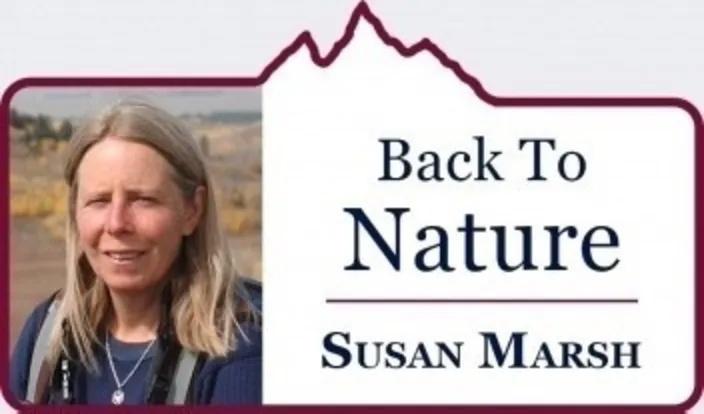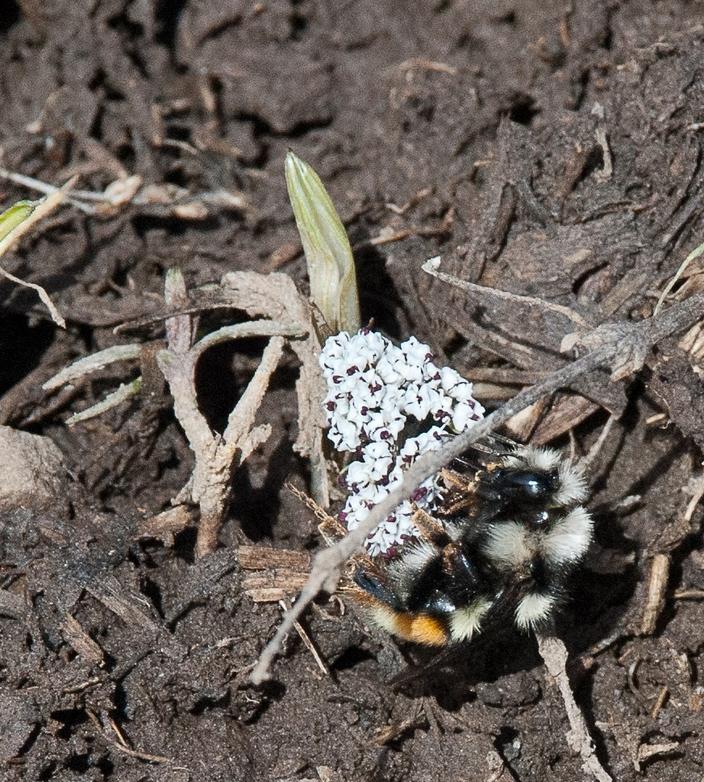Back to StoriesIn Praise of Mud Season
May 3, 2024
In Praise of Mud SeasonMoJo columnist Susan Marsh shrugs off the damp and cool of spring in the Northern Rockies to get outside and rediscover enchantment in the season
Story and photos by Susan Marsh
It takes practice learning to love mud season, when the skis
and snow shovels still clutter the front deck and hiking gear waits impatiently
behind the door. Many people pack up and head for warmer climates, while others
keep busy with indoor spring cleaning.
But venturing out during mud season is worth it. Among my
favorite things about this time of year is the quiet. You can cross a street in
the middle of town without seeing traffic coming in either direction; airport
noise is at a minimum; trailhead parking is never a problem.
Once afield, I find that mud season invites me to pay
attention to the subtle changes taking place. The grandeur of distant views
remains, but to be frank, those views look about the same as they have all
winter. While one never tires of looking at beloved river valleys and mountain
ranges, what I notice in spring are the most subtle of colors entering the
world. A hint of green in aspen bark and the pinkish-tan of catkins on the
branches above. The brightening sky and deep blue-gray on the undersides of cumulus
clouds.
I feel the boundary layer between air and earth awakening. For
a recent hike, I put on a wool hat and gloves, a turtleneck, a sweater, and two
windbreakers. It was 25 degrees with a stiff north wind. The crust on snowbanks
was so hard that my boots barely made an impression. By noon, the wind abated
and the sun shone, and I walked back down the slope with no hat or gloves, wearing
only one of the windbreakers. It wasn’t exactly tropical, but the change in a
few hours was remarkable, reminding me of how a bit of radiant heat from full
sun makes such a difference.
I wasn’t the only one to change my costume during those
hours. On the way up the south-facing slope, I was delighted to see a few buds
of cutleaf fleabane and Bessey’s crazyweed. On the way back down, I found that
some of those buds had opened into actual flowers. Time to celebrate.
While one never tires of looking at beloved river valleys and mountain ranges, what I notice in spring are the most subtle of colors entering the world.
Mud season has a unique feel to it. Where snow persists, a
chill hovers at ground level, the inverse of a day in late August when the sun
is at the same angle. In August, warmth collects among the curing grasses and
seed heads, and the earth itself feels warm when you lie down, even on a cool
and breezy pre-autumn day. In April, you scan for a boulder or fallen tree for
a seat—something dry and elevated, if only a couple of feet off the ground.
Each unfolding of the seasons is a gift, though some are
easier to appreciate than others. Mud season requires effort. It’s easy to talk
myself out of lacing up the clay-encrusted boots and going for it. Yet when I
prod myself out the door, I am never disappointed.
Some social critiques say that, compared to the world in
which our distant ancestors lived—one filled with magic, gods and wonder—ours
has become disenchanted. My experience tells me that the world itself is as
enchanted as ever, but our consumer-techno-pop culture has insulated us from
what our deepest selves know. If I feel disenchantment, I know it’s time to get
outside.
Some authors trace our sense of disenchantment to what we
have come to call “progress.” Rational thought upended wonder and myths, and we
have in many ways replaced our idea of “God” with ourselves. But what self-flattery
to imagine ourselves rational! We can observe with our senses an obvious cause-and-effect
phenomenon while continuing to deny it (think climate change).
I take issue with those who say we’ve lost our way because we
have abandoned religion, as if fear of divine punishment were the only thing
keeping us in line. As social creatures, we surely understand that our
agreed-to standards of behavior help society continue to function. Most of us
understand, to use a simple example, why it isn’t OK to blithely run a stop
sign. And I don’t think I have to make a choice between being a rational person
and finding wonder and design in the world. If anything, my background in the
sciences helps me appreciate the life cycle of a wildflower or aspen grove and
the symmetry of forms in nature more than I would otherwise.
So outward I go during mud season. It feels like some kind of
achievement to know where to find the first blooms of a favorite wildflower,
though the relationship I have with it is most certainly one-way. The plant,
whose roots have been stirring in the thawed soil and whose basal rosette has
gathered energy from the springtime sun, is only doing what it does every year,
and if it’s a long-lived perennial species, in the same place. I just happened
to come along during the process. And for me that’s cause for celebration.
Mud season holds small packages of surprise. Photos I have
taken yield what I did not see until I looked at the picture later. The
antennae of a tiny beetle on the underside of a leaf. Weathered elk pellets
fertilizing a spring beauty. An inconspicuous blossom beside the one I thought
I was photographing. Last year’s cicada nymph casing, a pocket of springtails, the
pattern of snow-flattened leaves and stems around the spring rosette of a
native thistle.
Each unfolding of the seasons is a gift, though some are easier to appreciate than others. Mud season requires effort ... Yet when I prod myself out the door, I am never disappointed.
Color can be hard to come by this time of year, so before the
flowers appear I turn my attention to patterns in cobbles, lichen and thawing soil.
On my recent hike I spotted a stone partially coated with caliche (a thin
calcium carbonate deposit). It suggested something other than random blotching—a
yin-yang symbol. It made me stop, admire it, and take a photo.
Old friends appear along with surprises. The first shy leaf
blade poking out of the mud, a wildflower that will not bloom for weeks, though
I recognize and greet it, blooming or not; the sound of the first-of-year
kinglet, or flicker, or grouse drumming in the woods.
Mud season is a good time to get out a hand lens. One year I
heard a tiny buzzing noise behind me as I sat on a dry patch of grass
surrounded by muck. I turned and saw it was a bumblebee, and only after the bee
moved did I see my first-of-year Orogenia, that miniscule member of the carrot
family whose white blossoms cluster into what looks at first glance like a lost
shred of snow. After the bee left, the Orogenia was visited by a Sheridan’s
hairstreak with its metallic green wings. Then an ant showed up to climb over
it, thus collecting some pollen to place on another plant. It was the story of
spring told in a brief sequence of visitations.
I suspect we all have our favorite wildflowers to look for this
time of year. I tell people that my favorite is the last one I saw, but I have
a few special ones, made special not only for their beauty but years of
memories, love for the places where I saw them and the people I was with.
Where soils of shattered rock bare off as early as March, one
might wander up a slope to be stopped by the sight of dozens of
saucer-to-platter-sized clumps of brilliant hot pink. Approaching one, you see
it is a cushion plant with so many blooms that the foliage disappears below
them. Among its names is dwarf primrose (Douglasia/Androsace
montana unless the experts have renamed it again). It’s what I used to look
for hiking up Red Mountain beside the Madison River.
On gravel benches and the lee slope of ridges, I search the
ground for steer’s head. I know many people who have lived here for decades and
say they have never seen one. It’s not very big, but it is distinct. It helps
to have a vision of the flower and leaves in one’s mind, and to know what kind
of soil and terrain it prefers. Related to garden bleeding heart, the steer’s
head flower resembles a bovine face. Its leaves are as lovely as the flower is
strange, dissected into graceful lobes with a blue-green cast. During years
when flowers are scarce, the leaves alone are a joy to find.
My experience tells me that the world itself is as enchanted as ever, but our consumer-techno-pop culture has insulated us from what our deepest selves know. If I feel disenchantment, I know it’s time to get outside.
For the next few weeks, I plan to spend my time communing
with the mud and finding enchantment among the ever-increasing variety of
wildflowers. Greeting the first lime-green aspen leaves now that the staminate
catkins are falling off. And rejoicing when I encounter a snowbank holding the
plate-sized tracks of wild, healthy wolves. Each time I see them, I say a
little prayer—not to any particular deity, but to the spirit of the “Sublette
wolf” who did not deserve the kind of treatment humans have dished out to his
kind of centuries. The wildflowers, and even slipping and falling in some mud,
mercifully take my mind off such horrors, if only for a little while.
A world of enchantment? Or one of willful ignorance and
cruelty? I guess that is up to us.
________________________________________________________________________________________________________________________
Mountain Journal is the only nonprofit, public-interest journalism organization of its kind dedicated to covering the wildlife and wild lands of Greater Yellowstone. We take pride in our work, yet to keep bold, independent journalism free, we need your support. Please donate here. Thank you.
Related Stories
October 7, 2024
The Ephemeral Beauty of Autumn
During the shifting of the seasons, columnist Susan
Marsh writes that the small things can bring peace of mind.
March 5, 2025
When I Need to say 'NO'
When we pick our battles, sometimes we must stand up and call
a spade a spade.
June 12, 2024
Squeezing the Waterways in Greater Yellowstone
As Jackson Hole swells with development, MoJo
columnist Susan Marsh writes that waterways like Flat Creek need our attention.







